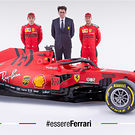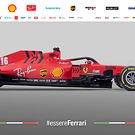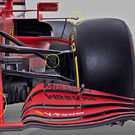Launch analysis: Ferrari SF1000
Ferrari launched their SF1000 in another spectacular launch event. The team showed off its scarlet car which is supposed to stay in the mix with Red Bull Racing and Mercedes before Formula One's major regulation overhaul in 2021.
With the regulations completely stable this season, major changes weren't to be expected, but looking closer to the new SF1000 shows that Scuderia Ferrari haven't been discarding this project in favour of 2021.
The front of the launched car still features a front wing that aims to optimise airflow around the front wheels, rather than having steep flaps in front of the front wheels. There was some doubt when Ferrari, Toro Rosso and Sauber came up with this solution at the start of 2019, but it is understood that this was not at all a weakness. One needs to wait if this design will stay though, as teams are not eager to show all details before testing, or even before the first race.

Ferrari continues with the thumb style nose, again with channels on each side of the thumb tip, rather than the open airflow apertures that used to be there some time ago. The same design was seen on the rendered Haas VF-20 that was presented on Monday, as both teams get their inspiration from Sauber's Alfa Romeo C38. The S-duct through the nose cone is also retained, with the outlet just at the connection with the chassis, again, very similar or identical to what was seen in 2019.
It needs to be noted though that there seem to be some rough finishes on the nose cone, indicating this may very well just be a launch part, with the actual 2020 specification coming up in testing.
Perhaps the most important change is the front suspension, of which Mattia Binotto said the team have adapted to be more adjustable, in an attempt to have more freedom to properly set up the car. With that statement, Ferrari's principal also hinted that last year's Ferrari's inconsistency between slow and fast tracks was partly due to this invariability.
One particular change that Ferrari seemingly 'copied' from Mercedes is the pivot point between the front wheels and the pushrods. On the SF90, the pushrod connected to the upright almost in line with the inner flank of the wheel. This year that pivot point seems to have been moved further inboard, connecting to an extension on the upright. It is believed this design element was a major driver for Mercedes' low-speed performance in 2019 as it is meant to help the car lower itself when the car is turning.
All wishbones continue to be mounted fairly low, staying out of the way from airflow that is supposed to feed the sidepod inlets, which continue to be at the very top of the sidepods. Though the inlet was redesigned, its philosophy stays the same, combined with a horizontal wing above and in front of the inlet. Such horizontal wing was already used by Red Bull and McLaren during the 2019 season. The team have also done away with the little "inlet window" on top of the sidepod, making the inlet, along with the half-covered wing mirrors all the more similar to Red Bull's RB15.
Lower down to the floor, the barge boards are another extreme package, featuring two boomerang-style elements connecting the chassis to the outboard panels that work the wake of the front wheels to control airflow around the sidepods. Very close to the chassis, the barge boards also reach out quite high, which is possible for elements very close to the actual tub. It's clearly just another way to extract every little bit of aerodynamic performance there is to find.
Still, this area, as well as the car's entire floor arrangement is typically changed as pre-season testing goes on, so there is little point in analysing much further.
Behind the cockpit, the airbox has also retained a narrow triangular shape, featuring a large air inlet underneath the main roll hoop aperture. On each side of the airbox, however, the team opted to re-introduce Viking horns. Thanks to their narrow airbox, there is the allowed space to attach these to the bodywork, most likely to drive rear wing performance by shedding a couple of vortices off the tips of these horns.
Towards the rear, the car has become narrower, though it appears that making some free space in between the bodywork and the inside of the rear wheels has come as the cost of raising the outlet of the sidepods. The lack of rear view images however means this isn't certain at all. Still, updates coming in the next weeks might totally change that picture once again.
Whether this will all be enough is a different matter, as Mercedes has undoubtedly not been sitting still either while Red Bull are fairly bullish on their 2020 chances, now that their Honda partnership has matured a bit. Track time will tell.







